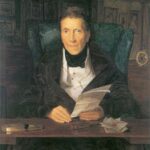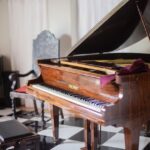The Archduke Trio is considered by many as the most beautiful piano trio Beethoven ever composed. It is also a turning point in his life as a public performer. In this article we explore this composition and its history.
The Archduke Trio (Op. 97) (in German Erzherzog-Trio or Erzherzogtrio) was composed by Beethoven from the summer of 1810 and finalized it in March 1811. The four movement, B-flat major composition for piano, violin and cello was premiered in 11 April 1814. It is referred as Archduke Trio because it was dedicated to Beethoven’s pupil, friend and patron Archduke Rudolph of Austria, who was the youngest child of Leopold II., Holy Roman Emperor.
The Archduke was initially a pupil and became a loyal friend to Beethoven, who dedicated fourteen compositions to Rudolph. This composition was Beethoven’s last piano trio work and his best known chamber music.
The first performance
The first performance was held at the Zum römischen Kaiser hotel in Vienna, 11 April 1814. Apart from Beethoven, Ignaz Schuppanzigh (violin) and Josef Linke (cello) were the performing musicians. By this time Beethoven’s deafness was almost complete and it became painfully evident during the performance.
During the play he was not able to hear his own piano music, either playing too hard or so soft that the audience was not able to hear it. A witness, Ludwig Spohr ( German violinist and composer) witnessed a rehearsal of the work, and wrote: “On account of his deafness there was scarcely anything left of the virtuosity of the artist which had formerly been so greatly admired. In forte passages the poor deaf man pounded on the keys until the strings jangled, and in piano he played so softly that whole groups of notes were omitted, so that the music was unintelligible unless one could look into the pianoforte part. I was deeply saddened at so hard a fate. It is a great misfortune for anyone to be deaf, but how can a musician endure it without giving way to despair? From now on Beethoven’s continual melancholy was no longer a riddle to me “
Another witness, pianist and composer Ignaz Moscheles gave similar report of the events. “In the case of how many compositions is the word “new” misapplied! But never in Beethoven’s, and least of all in this, which again is full of originality. His playing, aside from its intellectual element, satisfied me less, being wanting in clarity and precision; but I observed many traces of the grand style of playing which I had long recognized in his compositions.”
This performance had been the turning point for Beethoven and he never played piano in front of a public again.
The music
The Archduke Trio is structured in four movements, a grand composition almost like a symphony, but for only three musicians.
The first movement begins with the main theme, played on piano alone. A short intro and the other instruments also join the music one-by-one, then in harmony. Throughout the movement piano is somewhat dominant and often this is the instrument that introduces the new melodies.
The second movement is a lighthearted fun, called ‘scherzo’ (I joke in Italian). Here the strings have the initiation.
The third movement is considered by many as the heart of the work. For some it sounds like a religious hymn, for others like a love song. The whole movement is fragile and brilliant.
The fourth movement is again a carefree section, very different from the third. Full of humor and joy, playful and fun.






